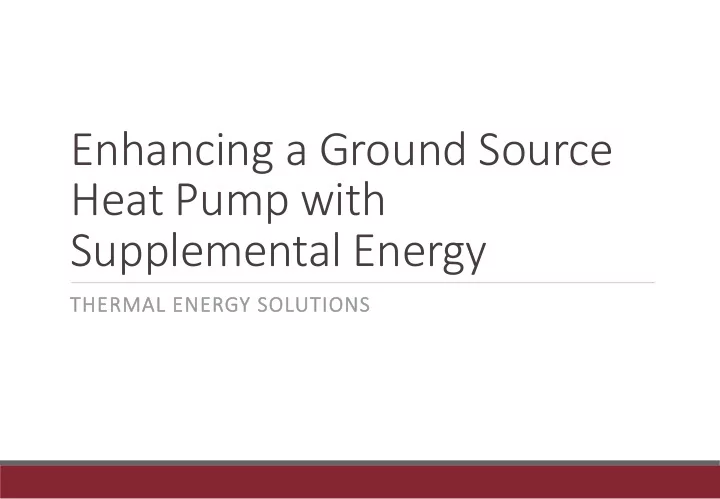

Enhancing a Ground Source Heat Pump with Supplemental Energy THERMAL ENERGY SOLUTIONS
Agenda Introduction Current home heating energy consumption Constraints Ground-source heat pumps System layout Supplemental energy sources ◦ Grey water ◦ Solar collectors Additional cost savings Conclusion
Introduction Four fifths of average Canadian Energy Consumption energy use can be attributed to 2% 4% heating (both space and 14% water). 63% Existing heat pump technology significantly reduces home heating energy consumption. 17% Our task is to improve home heating energy efficiency through enhancing the Space Cooling Lighting Appliances performance of a heat pump. Water Heating Space Heating
Current Home Heating Energy Consumption Based on residential heating in Atlantic Canada ◦ Energy required for space heating: 24,750 kWh ◦ Energy required for water heating: 5,650 kWh Three conventional heating methods ◦ Combustion: COP = 0.97 ◦ Electricity: COP = 1.00 ◦ Heat Pumps: COP = 4.00 Cost of heating ◦ Electric Heat: $3,586 ◦ Heat Pump: $982
Constraints Economic ◦ Heat pumps are already highly efficient ◦ Any improvements must be economically viable, with a reasonable overall system payback period Environmental ◦ Overall carbon footprint must be reduced ◦ It does not make sense to shift the problem from one place to another
Ground Source Heat Pumps Operating principles ◦ Based on the Carnot Cycle, which utilizes a power input to create a temperature difference between two thermal reservoirs. ◦ Energy is drawn from the ground, and passed into the home using a refrigerant. 𝑈 𝐼 𝐷𝑃𝑄 𝑁𝐵𝑌 = 𝑈 𝐼 − 𝑈 𝐷
System Layout
Supplemental Energy Sources Any supplemental energy source had to meet key criteria: ◦ Low up front cost, to ensure a reasonable pay back period ◦ Minimal inconvenience to the home owner Based on these criteria, two potential sources were selected for further study: ◦ Grey water ◦ Solar thermal
Supplemental Energy Sources Grey Water Water consumption facts: Water Usage ◦ Average Canadian consumes 5% 343 L of water per day. 10% 35% ◦ For a 4 person household, that amounts to 1372 L. 20% ◦ 480 L of this is hot water, which would be recoverable for energy harvesting. 30% Cleaning Kitchen Laundry Toilet Flushing Bathing
Supplemental Energy Sources Grey Water How the system would work: Water Usage ◦ Grey water would be collected 5% in an insulated storage tank. 10% 35% ◦ It would then be used to boost the temperature of the heat 20% pump ground loop. Energy potential: ◦ 480 L of grey water, at 40 °C, can impart 60,000 kJ of energy to the heat pump ground loop. 30% ◦ This would result in an average Cleaning Kitchen Laundry Toilet Flushing Bathing performance increase of 1.31%.
Supplemental Energy Sources Solar Thermal Solar thermal facts: ◦ The amount of recoverable solar energy varies widely by location within Canada. ◦ In Atlantic Canada, the insolation is relatively low, while in the Prairies, it is quite high (comparable to Sydney, Australia).
Supplemental Energy Sources Solar Thermal - GHSP How the system would work: ◦ The heat pump glycol loop would be redirected through the solar thermal collector. ◦ A 12 m 2 solar collector was selected. Energy potential: ◦ This would result in an average performance increase of 1.1% in Atlantic Canada. ◦ This would result in an average performance increase of 1.64% in the Prairies.
Supplemental Energy Sources Solar Thermal - Hot Water Heating How the system would work: ◦ Water would be pumped through the solar collector, heated, and then stored in an insulated tank. ◦ Two 2.5 m 2 collectors would be required for the average Canadian home. Energy potential: ◦ Atlantic Canada ◦ 94% in the summer ◦ 47% in the winter ◦ Prairies ◦ 100% in the summer ◦ 76% in the winter
Additional Cost Savings ADDITIONAL ADDITIONAL COST SYSTEM ENERGY SAVINGS SAVINGS (kWh) ENHANCING A GSHP GREYWATER 130 $13 SOLAR THERMAL - 400 $40 ATLANTIC CANADA SOLAR THERMAL - 540 $92 PRAIRIES STAND-ALONE GSHP AND SOLAR THERMAL WATER HEATING ATLANTIC CANADA 3200 $320 PRAIRIES 4720 $802
Conclusion We set out to reduce household energy costs by implementing an enhanced ground-source heat pump. There is one major problem with this: ◦ Heat pumps are too efficient It would be more efficient to use a GSHP to supply heat for space heating and use a solar collector system to preheat water for hot water use.
Thank you! Any questions?
Recommend
More recommend